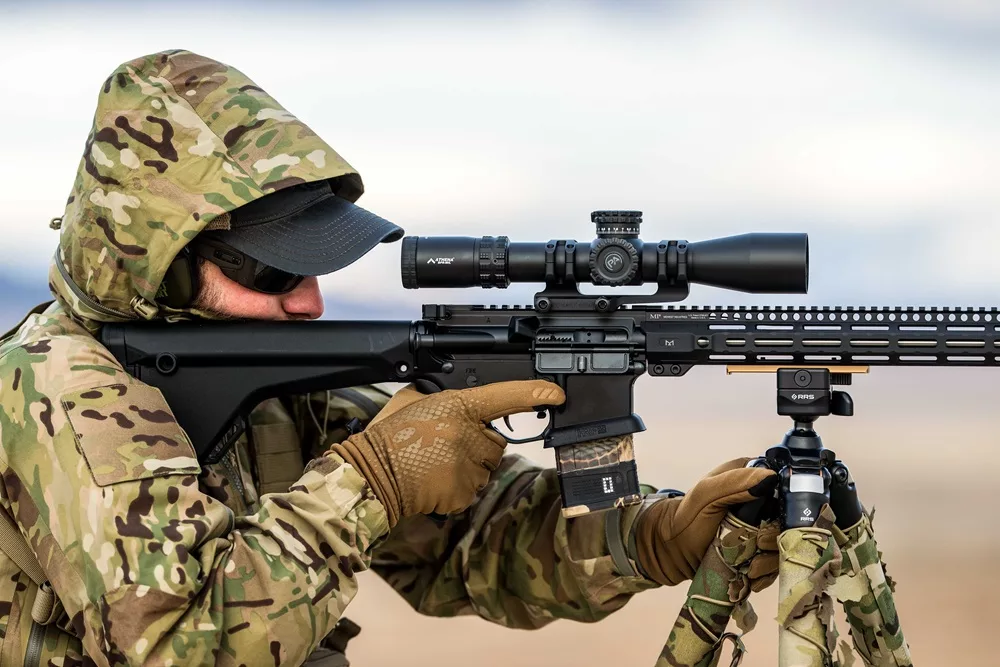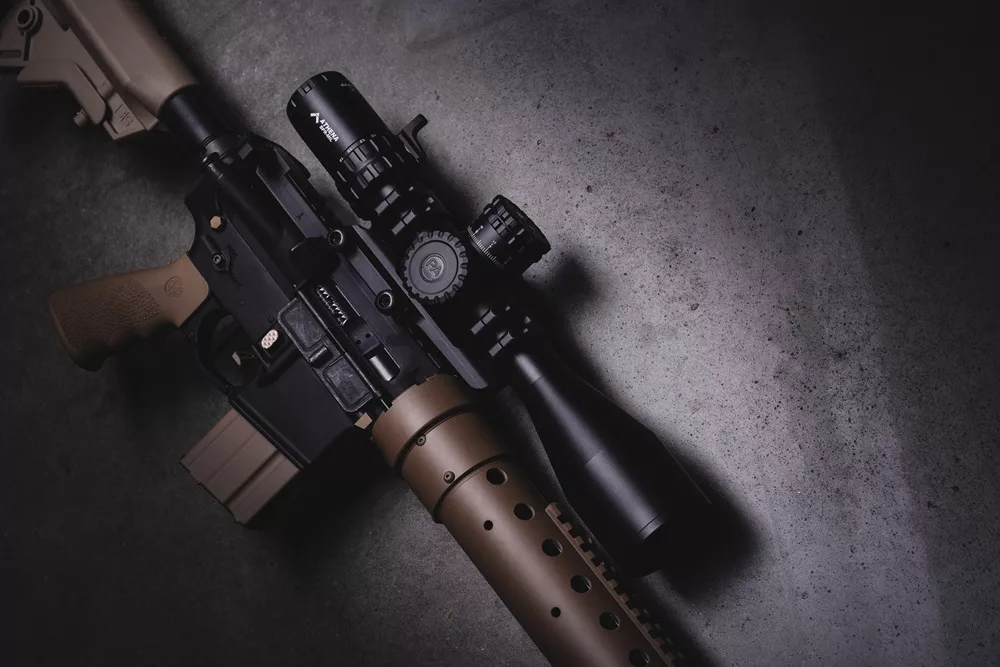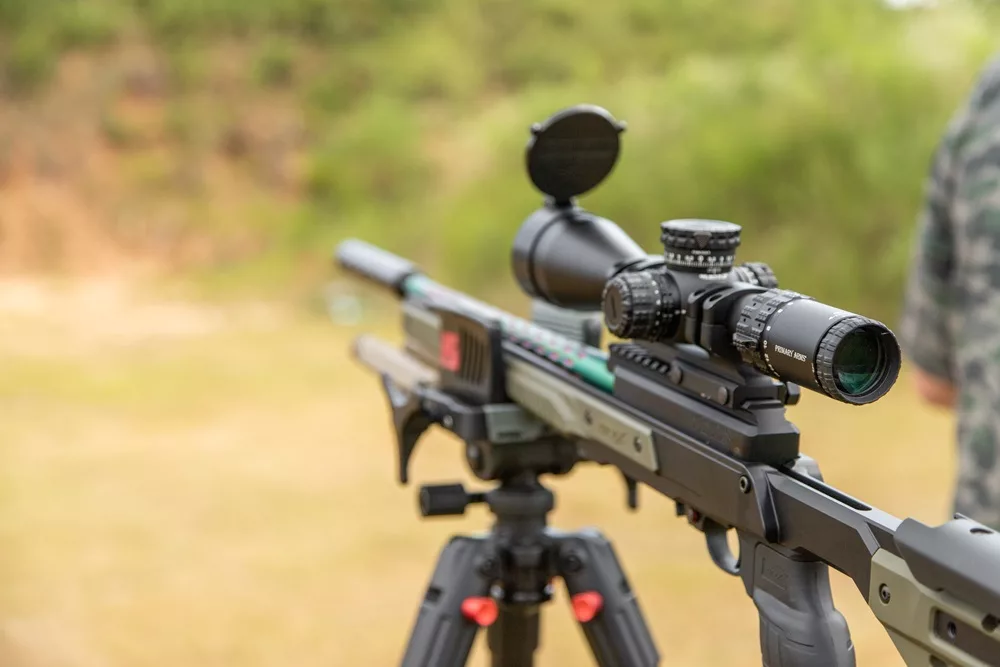For modern shooting disciplines, rifles can chamber a wide range of cartridges that can maintain accuracy up to thousands of yards away. Without a high-power optic though, your chances of landing consistent impacts on target aren’t as high, making a quality rifle scope paramount to your success.
Just as rifles have evolved, modern rifle scopes have significantly advanced as well, with new models being much lighter and more powerful. These attributes make them ideal for long-range precision, however when shooting at long ranges, you need to take several factors into consideration before taking your shot. Wind, elevation, and bullet drop are some of the most obvious considerations, but parallax often gets overlooked.
Parallax error can have a drastic effect on accuracy, so understanding how a rifle scope works and how to fix parallax error is crucial to maintaining accuracy at distance. Below, we’re looking at what exactly parallax is, and how to adjust your optic to counter it.

Understanding Parallax
Parallax is an optical phenomenon in which an object appears to shift in position when viewed from different angles or positions. To get a better idea of how it looks, place two objects in front of you but at different distances, with one in front of the other. While looking at them, move your head while focusing on the object in front. As you continue to move your head, the apparent placement of the objects will appear to shift, and you’ll see that the object closest to you appears to move much more than the one that’s further away.
When looking through a scope, parallax is an especially crucial factor to consider.
What is Parallax Error
In terms of rifle optics, scope parallax is the term used to describe an apparent misalignment between the optic reticle and the target image when you move your eyes or head position. Generally called parallax error, it can have a profound effect on your accuracy, causing you to miss your target by several inches or even feet in some cases.
While parallax error isn’t as much of a concern when shooting fast at close range, in long-range or high precision applications, it becomes a critical one. Ultimately, parallax adjustments are most necessary for medium to high-power rifle scopes designed for long-range precision. As you increase or decrease your distance from the target, you’ll push the sight picture past its parallax distance, requiring adjustments. Correcting this issue is necessary for long-range and precision shooting success, and fortunately, it can be overcome easily.

Parallax on Different Optics
Before we get into correcting parallax, it’s important to note how it can vary from optic to optic.
On variable power optics with lower magnification ranges, such as LPVOs and pistol scopes, parallax isn’t as much of a concern. Because of this, they rarely have any parallax adjustment and instead come pre-calibrated with a fixed parallax setting from the factory. This preset can vary depending on the optic type and manufacturer, so we recommend checking with the manufacturer’s specs to be certain that there won’t be any reticle movement at the distances you’ll be shooting at. This applies to prism scopes as well, with their performance being quite like those mentioned above.
Optics with no magnification, like reflex sights, are generally considered “parallax-free”, but this attribute only applies to them when they’re within a specific range, meaning your accuracy can still be affected by extreme angles and magnifier use. Within their usable range, the reticles of these optics will stay aligned with the target regardless of your head and eye position, making them an ideal for use in close-quarters and fast-paced shooting scenarios where speed and agility are needed.
As we mentioned before, rifle scopes that are designed for precision marksmanship often come with a parallax adjustment. For example, many of our long-range scopes with ACSS reticles come with an included parallax adjustment knob, but you’ll find them on scopes from other brands too, such as Nightforce, Steiner, Vortex Optics, and SIG Sauer.
The parallax adjustment knob is the most manipulated adjustment in precision shooting and is typically found on the left side of the scope, next to the windage and elevation turrets, or as an adjustable objective where you turn the Objective bell to “focus”. This allows you to fine-tune the reticle’s focal position in relation to your target image. Generally, parallax adjustments markings can vary depending on the optic, so it’s important that you familiarize yourself with what the numbers mean on your scope. In most cases, though, parallax adjustments usually increase in either 50- or 100-yard intervals, but like we said, this isn’t always true depending on the optic.

Correcting Parallax Error
Despite its potential impact on accuracy, adjusting your scope’s parallax is a relatively straightforward process.
Before you begin adjusting your scope’s parallax, we recommend looking at our guide on how to level a rifle scope to make sure that yours is both level and securely mounted to your rifle.
With your optic in place, turn the dial to the maximum adjustment setting. Parallax can be adjusted out to ‘infinity’, allowing you to easily make alterations regardless of your target’s distance to you. Once you’ve done this, you’re ready to start making your final adjustments for a more accurate sight picture.
Ideally, you’ll want to start by setting up a target with a neutral background at the distance you plan on shooting at. With the target visible through the scope, make sure that you have a proper cheek weld and eye position. Once your eye is centered on the reticle, you can begin adjusting your scope’s parallax, making small incremental adjustments. While doing this, keep checking for reticle movement by slightly nodding your head up and down, and side to side. Once your reticle stops moving off target, your scope’s parallax is set correctly for your distance, and you can stop adjusting.
Finally, with your optic adjusted, your long-distance shooting experience should improve greatly. Remember that your cheek weld and eye position is just as important as having the right parallax setting, but a properly adjusted parallax eliminates the error induced by poor scope/eye alignment. For standard range shooting, you shouldn’t have any issues keeping your eye placement consistent. However, in dynamic applications like long-range hunting, you may need to adapt to the situation. Practicing different shooting positions and becoming comfortable with your rifle will ensure that you’re ready for whatever the situation demands.
Conclusion
As modern scope technology has evolved to increasingly become more accurate across long ranges, the ability to adjust for parallax is a critical feature that’s necessary for any long-range shooting application.
Understanding the effects of parallax on your optic is essential. If ignored, your accuracy will suffer, especially when shooting at targets across vast distances. No matter which optic you end up going with, it’s important to the take ample time to research each option and its capabilities to ensure that it aligns with your preferred shooting discipline.
So long as you’ve researched each of your options, you’ll be good to go with whatever scope you choose. Remember, even top-tier rifle scopes won’t benefit you if they aren’t mounted properly. Our guide on zeroing in your rifle scope makes the process easy, walking you through it step-by-step.




